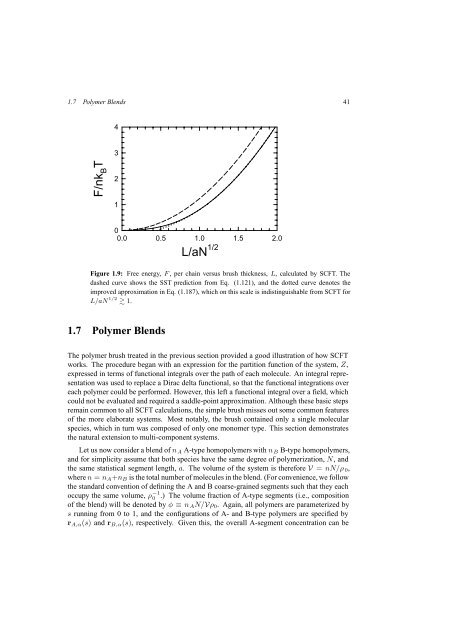Self-Consistent Field Theory and Its Applications by M. W. Matsen
Self-Consistent Field Theory and Its Applications by M. W. Matsen
Self-Consistent Field Theory and Its Applications by M. W. Matsen
Create successful ePaper yourself
Turn your PDF publications into a flip-book with our unique Google optimized e-Paper software.
1.7 Polymer Blends 41<br />
4<br />
3<br />
F/nk B<br />
T<br />
2<br />
1<br />
0<br />
0.0 0.5 1.0 1.5 2.0<br />
L/aN 1/2<br />
Figure 1.9: Free energy, F , per chain versus brush thickness, L, calculated <strong>by</strong> SCFT. The<br />
dashed curve shows the SST prediction from Eq. (1.121), <strong>and</strong> the dotted curve denotes the<br />
improved approximation in Eq. (1.187), which on this scale is indistinguishable from SCFT for<br />
L/aN 1/2 1.<br />
1.7 Polymer Blends<br />
The polymer brush treated in the previous section provided a good illustration of how SCFT<br />
works. The procedure began with an expression for the partition function of the system, Z,<br />
expressed in terms of functional integrals over the path of each molecule. An integral representation<br />
was used to replace a Dirac delta functional, so that the functional integrations over<br />
each polymer could be performed. However, this left a functional integral over a field, which<br />
could not be evaluated <strong>and</strong> required a saddle-point approximation. Although these basic steps<br />
remain common to all SCFT calculations, the simple brush misses out some common features<br />
of the more elaborate systems. Most notably, the brush contained only a single molecular<br />
species, which in turn was composed of only one monomer type. This section demonstrates<br />
the natural extension to multi-component systems.<br />
Let us now consider a blend of n A A-type homopolymers with n B B-type homopolymers,<br />
<strong>and</strong> for simplicity assume that both species have the same degree of polymerization, N, <strong>and</strong><br />
the same statistical segment length, a. The volume of the system is therefore V = nN/ρ 0 ,<br />
where n = n A +n B is the total number of molecules in the blend. (For convenience, we follow<br />
the st<strong>and</strong>ard convention of defining the A <strong>and</strong> B coarse-grained segments such that they each<br />
occupy the same volume, ρ −1<br />
0 .) The volume fraction of A-type segments (i.e., composition<br />
of the blend) will be denoted <strong>by</strong> φ ≡ n A N/Vρ 0 . Again, all polymers are parameterized <strong>by</strong><br />
s running from 0 to 1, <strong>and</strong> the configurations of A- <strong>and</strong> B-type polymers are specified <strong>by</strong><br />
r A,α (s) <strong>and</strong> r B,α (s), respectively. Given this, the overall A-segment concentration can be
















